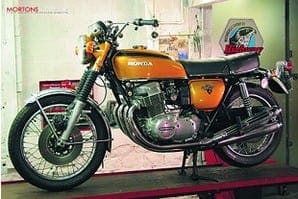
Our bike is a CB750 K1 manufactured in 1970 for the American market and is number 28,208 off the production line that year, with production starting from frame number CB750 – 1044650. The K1 has cosmetic and detail changes from the original model and was the first model to arrive here in the UK in any numbers, as we had to wait almost a year before any were available for our market. This bike has obviously been very well looked after but, after 33 years’ use, was obviously showing signs of ageing. Time, then, for a full strip and rebuild.
View the step-by-step instructions in the image gallery.
Image captions
Picture one: The old SOHC 750 Honda is almost unique among Japanese four-cylinder bikes in that it uses a dry sump lubrication system. Before the engine comes out these two oil pipes have to be disconnected. One pipe is the oil feed into the engine and the other is for the return to the tank; it's essential that they aren't connected up the wrong way round. Honda has designed these two bolt-on alloy unions so they can't be inadvertently swapped over, so after draining the tank I can simply unbolt them from the crankcase. Note the O-rings which seal them to the casing.
Picture two: Now the oil tank unbolts from its rubber mountings and lifts off with both pipes intact. The screw-on unions on the oil pipes have different threads on the tank, so they can't be accidentally swapped over here either. Good design, a shame that all dry sump engines aren't as simple to connect up as this.
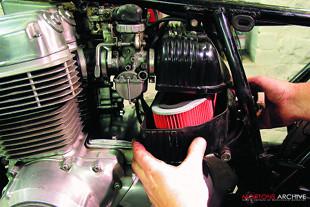 Picture three: Now the air cleaner. Again the Honda has an unusual design by modern standards. The still air box splits horizontally along the centre line and is held together with two wing-head bolts which are unscrewed from underneath. With the two bolts unscrewed the lower half lifts clear, revealing a brand spanking new air filter element. The two bolts are shouldered, rubber mounted and retained captive in the air box with washers and split pins – another example of Honda's quality engineering.
Picture three: Now the air cleaner. Again the Honda has an unusual design by modern standards. The still air box splits horizontally along the centre line and is held together with two wing-head bolts which are unscrewed from underneath. With the two bolts unscrewed the lower half lifts clear, revealing a brand spanking new air filter element. The two bolts are shouldered, rubber mounted and retained captive in the air box with washers and split pins – another example of Honda's quality engineering.
Picture four: The top half of the air box is bolted to the frame with two M6 bolts, and is sealed to the carb inlets with rubber hoses and clips. With all four clips unfastened and the two bolts removed it easily lifts out.
Picture five: Next, the carbs. I've removed the throttle cables from the rotor before releasing all four clips holding the carbs to the rubber inlet stubs, then the carb assembly simply pulls off the stubs and out of the side of the frame. For the time being I'm leaving the carbs in one piece and will strip and service them later, so for now I've drained the float bowls and wrapped them up in clean rag before storing them away.
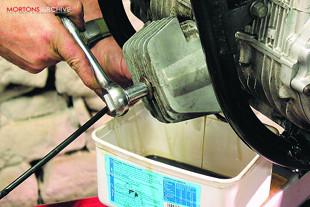 Picture six: The bike is still on its centre stand and is sitting on the rear wheel with a trolley jack under the crankcase. The next step is to drop the bike forwards off the stand, then I'll be able to remove the rear wheel and swingarm. To avoid damaging the oil filter housing as the bike drops forwards I'm removing it now. Then, with the help of my mate Patrick, I can gently rock the bike forwards off its centre stand and lower it onto the bench.
Picture six: The bike is still on its centre stand and is sitting on the rear wheel with a trolley jack under the crankcase. The next step is to drop the bike forwards off the stand, then I'll be able to remove the rear wheel and swingarm. To avoid damaging the oil filter housing as the bike drops forwards I'm removing it now. Then, with the help of my mate Patrick, I can gently rock the bike forwards off its centre stand and lower it onto the bench.
Picture seven: Now I can release the rear wheel from the end of the swingarm, unhook the chain off the sprockets and pull the wheel out backwards. The Honda has removable end caps on the swingarm so it's not always necessary to pull the wheel spindle out to remove it, particularly if the split link has been removed from the chain. In this case I've opted to pull the spindle out, which gives me room to move the wheel far enough forward to unhook the chain off the sprocket without splitting it. I can now rock the bike forwards onto the front frame rails to help get the wheel out.
Picture eight: The swingarm is held in place with a single bolt which passes right through the frame. I've unbolted and removed the shock absorbers before taking the bolt out. The swingarm then waggles backwards out of the frame and pulls clear. Note the two grease seals between each end of the swingarm pivot and frame mountings.
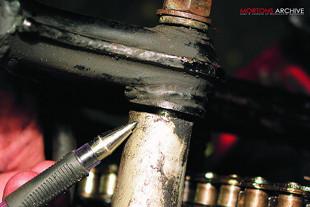 Picture nine: Removing the engine should now be a doddle. There are a total of six mounting points, and with all the studs and bolts undone the engine should simply lift out. Before ploughing ahead though I've just paused to note this gap which opened up at the top rear engine mounting when I unbolted the stud. These early CB750s could snap drive chains on occasion, and frequently the crankcase would suffer as a result. I'm wondering if this crankcase has been damaged and repaired in the past, resulting in a poor fit here. At the moment there's too much grease and muck on the engine to tell, but I'll be taking a good look at this area of the crankcase once the engine is stripped and degreased.
Picture nine: Removing the engine should now be a doddle. There are a total of six mounting points, and with all the studs and bolts undone the engine should simply lift out. Before ploughing ahead though I've just paused to note this gap which opened up at the top rear engine mounting when I unbolted the stud. These early CB750s could snap drive chains on occasion, and frequently the crankcase would suffer as a result. I'm wondering if this crankcase has been damaged and repaired in the past, resulting in a poor fit here. At the moment there's too much grease and muck on the engine to tell, but I'll be taking a good look at this area of the crankcase once the engine is stripped and degreased.
Picture 10: The engine bolts should simply pull out, but here I hit a snag. Thirty-three years of dirt and corrosion have seized the front lower engine stud solidly in position, and it refuses point blank to shift. Gentle tapping with a copper mallet establishes the stud is fast in the crankcase and is not rusted into the frame, so it's out with the old hacksaw again. I'm not going to risk damaging either the frame or the crankcase; gently spreading the frame off the engine just gives me room to get a hacksaw blade in and slowly and painstakingly cut the ends off the stud. This does leave the seized stud locked in the crankcase, but I can get that removed later.
Picture 11: Finally, engine removal. By far the easiest way to do this is to lay the bike on its right hand side, then lift the frame off the engine. This is still a tight fit and it takes a good bit of waggling about to get it clear, but at last it comes away. It will be tricky reassembling it after it's all been polished and powder coated, but I'll worry about that later. Note the rags under the engine, it's all too easy to damage the right hand engine covers if handled carelessly. And that's the bike stripped into big lumps. Brew time!
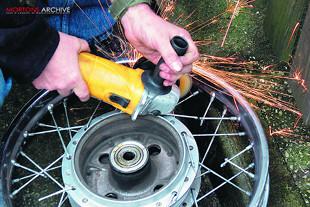 Picture 12: The plan is to get the wheels re-laced with stainless spokes and it will take some time to get the spokes made, so I'm opting to get the wheels stripped and off to the wheel builder straight away. Before stripping the wheels down it's crucial to measure the rim offset, that is to measure how the rims align to the hubs as they aren't always central. I've laid each wheel horizontally on a flat surface then measured upwards to the rim edge. I've then made a sketch of each wheel showing these measurements to pass onto the wheel builder. Finally I can chop the hubs out of the rims by slicing through them with an angle grinder.
Picture 12: The plan is to get the wheels re-laced with stainless spokes and it will take some time to get the spokes made, so I'm opting to get the wheels stripped and off to the wheel builder straight away. Before stripping the wheels down it's crucial to measure the rim offset, that is to measure how the rims align to the hubs as they aren't always central. I've laid each wheel horizontally on a flat surface then measured upwards to the rim edge. I've then made a sketch of each wheel showing these measurements to pass onto the wheel builder. Finally I can chop the hubs out of the rims by slicing through them with an angle grinder.
Picture 13: The Honda's wheel rims are in pretty good nick, but the edges of the rear rim are showing a few battle scars from years of tyre changing. Re-chroming the rims is tricky and expensive, and replacing them with new ones means I'll have to use different rim profiles and it won't be any cheaper. After some deliberation we opt to re-use the original rims. We're not aiming for a full concours restoration with this bike and some evidence of its 33 years' faithful service seems appropriate.
Picture 14: Now let's take a look at that iconic front brake. I've separated the two caliper halves from their mounting plate by removing two high tensile Allen bolts. Only one caliper half carries a hydraulic piston, and by leaving the hydraulic system intact I can now pump the piston out of the caliper body with the front brake lever. And here's the first mini horror story. These early caliper designs didn't have dust seals, which means water and salt has been creeping between the piston and caliper body for years corroding up everything in its path.
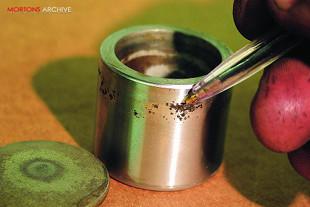 Picture 15: With the piston removed and cleaned up I can see the extent of the pitting on the working surface. Any pitting here will damage the fluid seal and could cause the brake to lose pressure, so this will have to be binned and replaced with a new piston. The inside of the caliper body has fared better, and will clean up with a little Scotchbrite.
Picture 15: With the piston removed and cleaned up I can see the extent of the pitting on the working surface. Any pitting here will damage the fluid seal and could cause the brake to lose pressure, so this will have to be binned and replaced with a new piston. The inside of the caliper body has fared better, and will clean up with a little Scotchbrite.
Picture 16: However before I can clean it up it will need a thorough cleaning up in the parts washer. The sludge in the bottom of the caliper bore is accumulated crud from the hydraulic system, which probably has not had its fluid changed this century. The black ring half way up the bore is the fluid seal which will be replaced when I rebuild the brake, and the rusty grime at the top indicates where the brake pad has been rusting away at the edges. Horrible.
Picture 17: That's the hydraulics taken care of, next the mechanical side of the caliper design. The Honda caliper only has a piston on one side, so the whole caliper body is mounted on this swinging plate. The hydraulic action therefore brings both pads into contact with each side of the disc. The whole plot pivots on a pin at the left hand side, and this pin is notorious for either seizing up or wearing loose in its pivot. Sure enough this one wobbles about in the mounting, and though I've seen worse I'll be sending it out for re-bushing before using it again.
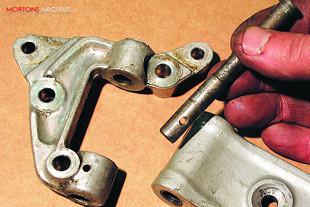 Picture 18: This is how it looks stripped down. There's wear in both the pivot plate and the pin mounting bracket and the easiest cure may be to ream them both out and make an oversize pin. Two small O-rings sit between the pivot pin and the plate to seal in grease and stop the pin seizing.
Picture 18: This is how it looks stripped down. There's wear in both the pivot plate and the pin mounting bracket and the easiest cure may be to ream them both out and make an oversize pin. Two small O-rings sit between the pivot pin and the plate to seal in grease and stop the pin seizing.
Picture 19: Up at the top end of the hydraulic system, probably the trickiest part of the whole stripdown is getting the tiny circlip out of the master cylinder to allow the release of the piston assembly. This circlip is buried deep in the cylinder body and requires the use of carefully hunted down long nose pliers, ordered specially by my local tool suppliers. With the circlip released the piston assembly slides out of the housing to be replaced with a new one for the rebuild.
Picture 20: Here are the component parts of the front master cylinder. At the top is the brake lever, cylinder cap and diaphragm; below them, left to right, is the piston dust seal, circlip, piston assembly and return spring and the cylinder body itself. Originally the cylinder bodies were anodised black, I'll be getting this one re-finished by powder coating it.
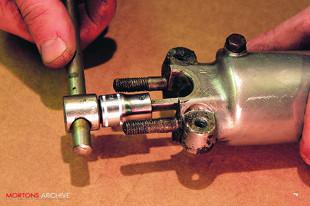 Picture 21: Next on the list, the front fork legs. Each fork leg is held together by an M8 Allen head screw buried up inside the bottom of the slider. This screw actually engages with the shuttle valve inside the fork leg, and if you're unlucky the whole assembly will turn inside the fork instead of unscrewing, necessitating the use of a special tool to hold it steady. I've left the fork spring in to give me a fighting chance, and a sharp crack with a good quality Allen key frees off the screw.
Picture 21: Next on the list, the front fork legs. Each fork leg is held together by an M8 Allen head screw buried up inside the bottom of the slider. This screw actually engages with the shuttle valve inside the fork leg, and if you're unlucky the whole assembly will turn inside the fork instead of unscrewing, necessitating the use of a special tool to hold it steady. I've left the fork spring in to give me a fighting chance, and a sharp crack with a good quality Allen key frees off the screw.
Picture 22: Now I can undo the top nut to release the spring from the stanchion. The easiest way to hold the stanchion is to clamp it back into one of the yokes, which can be held in a vice.
Picture 23: Before the two halves of the fork can be separated this circlip needs releasing from the top of the slider. On this bike there's obviously been a lot of water penetrating past the fork gaiters, and there's quite a build up of rust. The circlips still pop out quite easily though and this looks worse than it actually is.
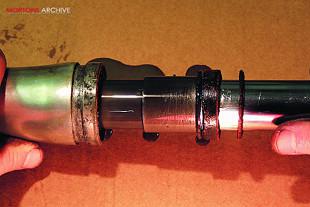 Picture 24: The CB750 forks have bushes in each leg, one at the bottom of the stanchion and one pressed into the top of the slider. To separate the two halves of the fork leg I'm now pulling the stanchion up in the slider like a slide hammer to progressively knock the top bush upwards out of the slider. Eventually it comes free and the two halves of the fork leg are split.
Picture 24: The CB750 forks have bushes in each leg, one at the bottom of the stanchion and one pressed into the top of the slider. To separate the two halves of the fork leg I'm now pulling the stanchion up in the slider like a slide hammer to progressively knock the top bush upwards out of the slider. Eventually it comes free and the two halves of the fork leg are split.
Picture 25: And here's the bits of one of the fork legs. At the top is the slider with the shuttle valve assembly on the left, below that is the spring and top nut with the Allen screw on the right and at the bottom is the stanchion with (left to right) circlip, washer, fork seal, top bush and bottom bush still in place.
And that's it for now. ![]()
To view the other four parts in this overhaul, please subscribe.




